-
- Samoa Map
Map of Upolu
-
|
-
-
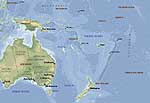
-
-
-
Map of
-
the Pacific
-
|
-
-
-
-
|
- latest picture: August 1, 2009
- click a picture to see details
|
-
-
-
-
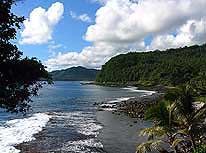
|
-
-
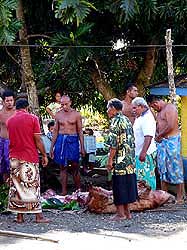
|
-
-
-
-
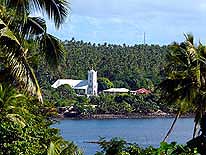
|
- 67
On the Northeast coast,
- the palm covered hills
- meet the Pacific Ocean
|
- 68
A pig is slaughtered for a
- funeral ceremony. A funeral belongs
- to the “fa’a Samoa”, the Samoan
- way of life and it can last the whole
- day. Generous gifts are exchanged
|
- 69
The village church of Falefa,
- nestled between a grove of palm
- trees on the Northeast coast
|
-
- Every morning at dawn, we are drawn to the sea shore directly in front of
“our” house. It is always a happy moment to experience the awakening of a new
day. We watch the swarms of jumping fish gliding like silver arrows over the motionless
surface of the lagoon, and the dark silhouettes of the fishing boats far out at sea.
Punctually like a clock a group of black bulbul birds is assembling regularly on a dry
twig right above our heads, chirping happily into the new day. When the yellow or red ball
of the sun rises from the ocean, changing the towering dark clouds into a glowing red and
transforming the skies into a fascinating palette of colors – each day in a different
one – we feel very privileged to be able to experience this wonder of nature day by
day. If in our Taiwan report we mentioned
that sunrises usually do not belong to our priorities, Samoa has now completely changed
our mind.
|
-
-
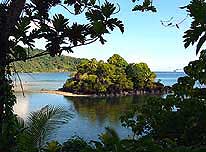
|
-
-
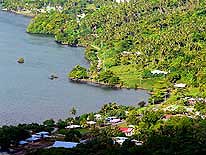
|
-
-
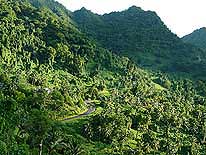
|
- 70
A tiny uninhabited island is
- greeting on the Northeast coast
|
- 71
Scattered hamlets dot the coast
- of the Fagaloa Bay in the Northeast.
- In the front Taelefaga
|
- 72
Forested mountains, luxury vegetation
- and palm groves dominate the scenery at the
- “Le Mafa Pass“ road in the East of the island
|
-
- With merely 100 miles of circular road and three North-South-Crossings of totally 50
miles, we decide to divide our island exploration into four daily tours. Equipped with
beer, bread, cheese, ham, cucumber and avocado salad in our car refrigerator, we start to
our first trip bringing us over the 2’300ft. high Cross Island Pass towards the South
and back to the North over the Eastern Le Mafa Pass. A cooler climate is greeting us on
the pass of the Cross Island Road, its alpine vegetation and grazing brown cows reminding
us of Switzerland. But as soon as we reach the South Coast the intense island feeling
returns. The road is narrow and passes through villages with their traditional
“Fale” nestling dreamily in lush tropical vegetation. Even the most modest of
the dwellings is surrounded by a richness of multicolored plants and flowers.
|
-
-
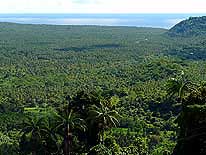
|
-
-
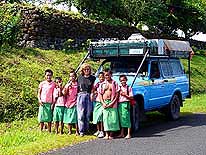
|
-
-
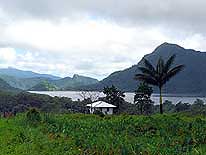
|
- 73
Palm trees stretching down to the
- sea in the Northeast. View from the
- “Le Mafa Pass” road towards the North
|
- 74
School children pose for a picture
- together with Liliana near Aufaga
- along the Eastern South coast in
- front of our LandCruiser
|
- 75
Branching off from the
- “Le Mafa Pass” road into the
- “Richardson Road”, the road winds
- along the peaceful Apulilo dam
|
-
- Mid morning we are already at the lovely Togitogiga waterfall that rushes through
tropical scenery into two refreshing pools. We enjoy this lovely place until a group of
young Australian surfer joins. Then it is definitely over with the peace and time for us
to go on. Shortly after, we arrive at the turn-off of the La Mafa Road leading back North
where there is just another impressive waterfall to admire: The 177ft. high Sopoaga
embedded in luxury green. Caught by the rays of the sun, it is a wonderful sight.
|
-
-
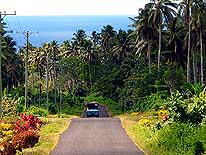
|
-
-
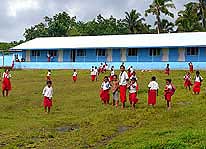
|
-
-
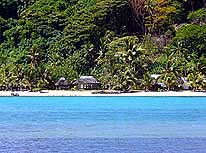
|
- 76
Flowering plants, flowers and
- palm trees – the island of Upolu is
- a beautiful tropical garden wherever
- we drive. Here near Samusu
- in the extreme East
|
- 77
Children of the Tiavea Primary
- School in the East in front of their
- school building. Village schools are
- always built in the same way and are
- embedded in the tropical vegetation
|
- 78
The small beach of the deeply
- forested Namua Island in the Fareast
- District of Aleipata looks promising
|
-
- Brilliant green surrounds us when we continue our journey through the windy mountain
road with vistas over an immense forest of coconut palms stretching as far as to the sea,
and mountains with exuberant vegetation. There is only one thing that dampens our
enthusiasm: We are really hungry. Up to now we did not find one single place to pull out
and eat our picnic. And it is already mid-afternoon. When a narrow road branches off in
Falefa towards Fagoloa Bay, we follow it, and when finally we find a spot where the trees
have been cleared and the view to the lagoon is free, we just park along the road. There
isn’t any traffic anyway. After appeasing our hunger and thirst, we are ready for new
adventures.
|
-
-
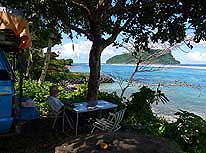
|
-
-
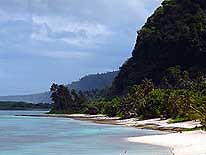
|
-
-
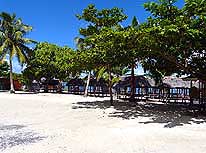
|
- 79
Picnic at Cape Tapaga at
- the far Southeastern corner
|
- 80
The white sandy beach of
- Lalomanu stretches along the
- Southeastern corner of the Island
|
- 81
Very simple beach accommodation,
- known as “Beach Fale”, can be rented
- everywhere along the Southeast coast
|
-
- The mama with her two small children is still sitting on the same spot along the road
near the Falefa waterfall and is making skillfully mats out of fresh coconut leaves, when
we return to the main road. “They will be used to cover the roof of my newly built
“Fale”, she explains. She takes four layers, folds them in the middle over a
coconut strip and stitches them together with a natural thread. ”Roofs made out of
palm leaves keep the place cooler than corrugated iron”, she tells us. All the same
more and more are replaced by tin roofs needing less maintenance. As a gift, she opens a
coconut for each of us to enjoy the refreshing water – a lovely gesture. We thank her
and are hitting the road again.
|
-
-
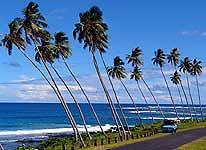
|
-
-
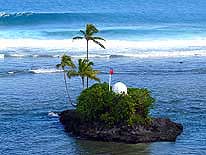
|
-
-
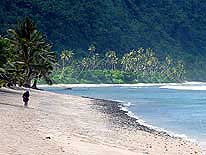
|
- 82
We enjoy our trip along the
- palm fringed Southeast coast. In
- Samoa, the roads often run
- directly along the sea shore
|
- 83
A tiny island, washed by the
- waves of the Pacific Ocean, is the last
- resting place of the Head Chief of the
- village of Aufaga at the Southeast coast
|
- 84
A woman is looking for sea
- shells at the deserted Faofao Beach
- along the Southeast coast
|
-
- “Once you will be in Samoa, you have to visit also Tokelau”, a lady from New Zealand we met in Fiji
recommended us warmly. “There is no airport; there are no roads and no cars. Life is
still as it has been 100 years ago”. She talks so enthusiastically about the three
small atolls lying North of Samoa, a territory still belonging to New Zealand, that after
our arrival in Apia, we immediately apply at the Tokelau Liaison Office for a 10 days
visit, from May 19th, to May 29th, what is also granted. However, what I am not really
looking forward to is the 20+ hours sea journey on a small wobbly vessel. But finally, it
is not going to happen anyway! To be blamed is the recent outbreak of the swine flue,
originating in Mexico, and spreading worldwide. The WHO has put the alarm level on No. 5,
what made the Government of this remote Pacific archipelago with only 1’500
inhabitants cancel all passenger arrivals until further notice. Understandably: Only two
months ago, they were hit by a nasty flue epidemic, having to ask for medical aid from New
Zealand. Of course, they do not want to have it repeated worse. For us it is most
regrettable; we were really looking forward to this remote place.
|
-
-
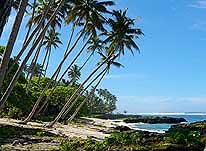
|
-
-
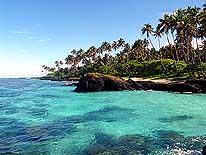
|
-
-
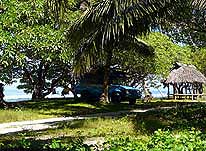
|
- 85
|
- 86
|
- 87
|
- Salamumu Beach in the Southwest of the island of Upolu is another place where we stop
for the day
|
-
- Most of the lovely sandy beaches are found on the South Coast, like also the
“Return to Paradise Beach” situated in the South West – the destination of
our second island tour. It got its promising name from the same named film that was shot
here in 1951 with Gary Cooper as main actor following the novel of James Michener. Also
today, we particularly enjoy the traditional breezy “Fale” along the road, the
beauty of the colorful plants and flowers, the peace and the rural feeling. We watch the
fat mother pigs, followed by their battalions of piglets roaming freely and the many
scavenging cocks and chicken.
|
-
-
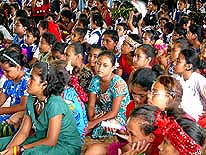
|
-
-
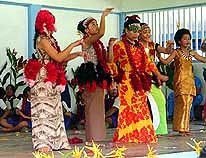
|
-
-
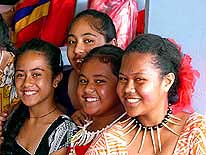
|
- 88
|
- 89
|
- 90
|
- School children are celebrating in the ”Savalalo School Hall” in Apia with
lovely dance performances
|
-
- Mid-morning, we are already approaching the famous beach. Like everything on this
island, also here is an access fee to be paid. On a board that stands in the middle of
nowhere, the tariffs are clearly marked. Therefore, we give the young man who comes
running breathlessly 10 Tala ($3.40). He shakes his head. “It costs 20 Tala” he
insists. „You are a minibus“. After a painful discussion, he finally gives in.
Either he agrees that we are not a minibus, or he realizes that we will not pay one Tala
more than the correct official price.
|
-
-
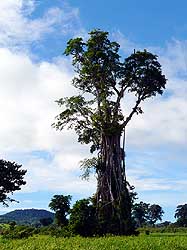
|
-
-
-
-
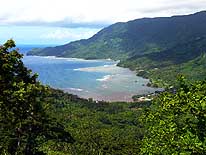
|
-
-
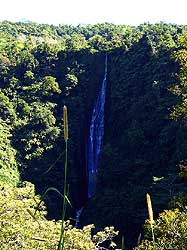
|
- 91
A Banyan tree (fig tree) towers
- into the blue sky at Aleisa Heihts, in
- the interior of the island West of Apia
|
- 92
Fagaloa Bay in the North East
- is known as the wildest and most
- beautiful bay in Upolu
|
- 93
The Papapapai-tai Fall on the
- Cross Island Road is 330ft. high
- and plunges into a forested gorge
|
-
- On Saturdays, the beach usually gets busy with local families. Today, we have the place
entirely to ourselves and enjoy the South Pacific atmosphere – the rustling of the
coconut palm trees and the turquoise sea. We have almost finished with our picnic when a
young guy comes along and offers us each a coconut that he just collected nearby. He joins
us and we start talking. But already after a short time he is lamenting that he has no
money to feed his two small children. “Not again”, we think. We therefore pay
him for the coconuts – which actually we thought to be a gift – three times more
than the market price. But he is not satisfied. He still expects us to give him another 20
Tala, what we refuse. Yes, it proves once more – and unfortunately not for the last
time – that people all over the world are spoilt everywhere where money has been
distributed to them generously – be it by tourists, or like here by a foreign filming
company, or in Africa by the passing Paris-Dakar-Rally. When shortly after this intermezzo
rain starts to fall, we head back “home”.
|
-
-
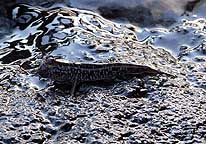
|
-
-
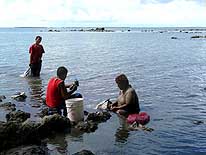
|
-
-
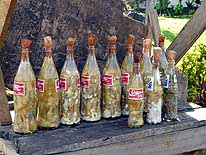
|
- 94
At low tide, a mud skipper
- is crawling on the black
- stones on the sea shore
|
- 95
Sea cucumber are cut in the
- middle with a knife to extract the
- edible intestines .....
|
- 96
.....that are filled in Coca Cola
- bottles and sold at stalls along the road
|
-
- On our third exploring tour, we only hit new land when we branch off from the Le Mafa
Pass to the Richardson Road leading East. We pass the Apulilo dam, nestled into deeply
forested hills, and drive through colorful tropical scenery to the Southeasterly corner of
the island. Hamlets and small offshore islands dominate the peaceful landscape from Samusu
to Cape Tapaga. Exactly where the road turns West again, we spot a narrow piece of land
sandwiched between the road and the ocean. There is hardly enough place to park our car.
But as it is lunchtime anyway, we decide to make a quick break and eat a bite. The road
has very little traffic und we enjoy the lovely sea view. Suddenly a pick-up stops besides
us and a woman gets out of the car and walks straight away towards us. Despite that two
wheels of our car are still parked on the pavement, she insists in an unfriendly way that
this is her land and we have to pay for using it. We have not the slightest desire to get
involved in a discussion and clear the place. This is not anymore Samoa as we are used to.
Until now we met only friendly people with smiling faces, waving to us and showing a real
interest at our epic journey.
|
-
-
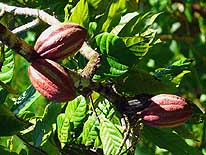
|
-
-
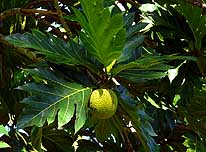
|
-
-
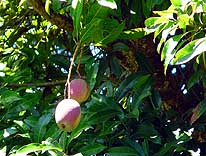
|
- 97
Cacao fruits .....
|
- 98
..... bread fruit, besides Taro
- a main diet of the Samoan people .....
|
- 99
..... and Mangos
|
-
- And a few minutes later, in Lalomanu, it happens again: Emil is parking at the side of
the road and remains seated in the car, while I rush the few yards down to the beach to
have a quick look at what the Lonely Planet guide describes to be one of the loveliest
beaches in Samoa. I am back in less than three minutes, but Emil already has been
questioned by a woman. While pointing to me, she asked Emil: “Where is she
going?”. Emil: “She just wants to see what the beach looks like”. Woman:
“It is my beach, she has to pay for”. Later we hear of another story that
happened also here. At the end of their trip, German tourists in a minibus wanted to drink
a beer at the beach restaurant that costs 4 Tala. But they were asked to pay 20 Tala each
just for accessing the restaurant. And what happened? The tourists renounced the drink and
drove off disappointedly. And this is exactly what we do too. We wonder if this
exaggerated behavior is in accordance with any “village protocol” to scare
tourist away.
|
-
-
-
-
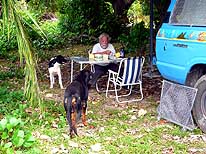
|
-
-
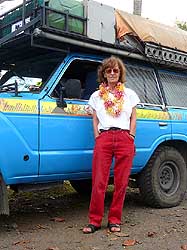
|
-
-
-
-
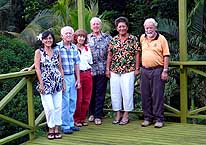
|
- 100
A lunch break under a shady
- tree near the Apia harbor. Two stray
- dogs want to share our food. There
- are many of them in Samoa and
- surprisingly, they all seem quite well
- fed. It’s now tried to get control of
- their numbers in desexing them
|
- 101
At the celebration of our
- 9’000th day on the road around
- the world on June 7th, 2009,
- Liliana is adorned in the Pacific
- style with a fresh flower garland
|
- 102
After enjoying a lovely lunch with
- Marco, our Swiss Honorary General Consul
- in Samoa and his Chilean wife Ines-Maria
- – in their remote “farm” at Fasitoouta in
- wonderful tropical surrounding – we pose
- for a remembrance picture. From right: Emil,
- Tautala, Marco, Liliana, Steve, Ines-Maria
|
-
- We later heard that in the year 2000 the last Camel Trophy – arriving from Tonga
– landed here in Lalomanu with their rafts and paid US$1’000 per day to the
community for the (TV-) show. Is that the reason why people got so greedy? Despite of
those two negative experiences we remain in good mood and enjoy the lovely drive along the
seashore. From Lalomanu to Saleapaga the rows of open-air beach houses never end – it
is said to have 285. We did not count them! Most of them are empty now. As romantic as it
might sound to sleep the traditional Samoan way, we are not attracted to it and are happy
to return to our house where we have more privacy.
|
-
-
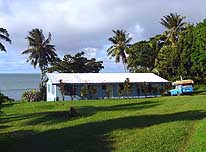
|
-
-
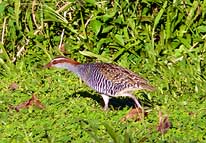
|
-
-
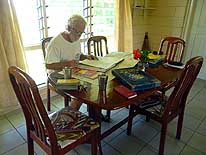
|
- 103
“Our” rented house in Puipaa, where
- we spent ten relaxed weeks being in Samoa
|
- 104
“Our” nearly flightless Buff-banded
- Rail that pleased us daily with its presence
|
- 105
Emil at the middle-term planning of our
- next trip destinations in “our“ house in Puipaa
|
-
- Already in Vanuatu the two electrical
fuel pumps of our LandCruiser started to make problems. Later in the Fijian capital Suva, it was not possible to find an adequate
replacement, not even with the assistance of Toyota. The pump ordered directly by a spare
part dealer in Australia turned out to be the wrong one on
its arrival. It was a mess, because our good old “buddy” was not even capable to
climb any moderate hill anymore. What now? According to the motto: “ Help
yourself” Emil climbed to the roof of our car and grabbed seven old pumps out of our
spare part aluminum case that he never wanted to get rid off. Taking his time and with his
inherited patience, he tried one after the other and – miraculously – two were
still working halfway. He built them in, and with this emergency repair we made it even to
Samoa. Not that they were failing yet, but they are not very far from it.
|
-
-
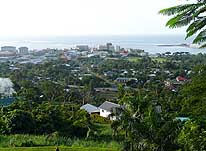
|
-
-
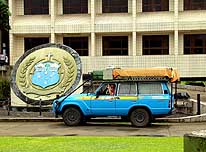
|
-
-
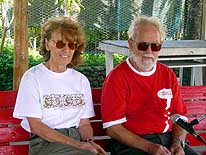
|
- 106
View over the capital
- Apia from Mt. Vaea
|
- 107
We are driving passed the
- Government Building in Apia
|
- 108
Liliana and Emil at a press conference
- before leaving for American Samoa
|
-
- Thus, our fourth and last island tour in Samoa becomes a real nightmare. After spending
a relaxed day at the wild Salamumu Beach in the Southwest of the island, we head back over
the 2’300ft. high Cross Island Pass. The Southern ascent is considerably steeper than
the Northerly one and of course the fuel pumps fail always at the most dangerous, most
narrow and most steepest place. Many times we have to roll back considerably to be able to
pull out of the road before trying our luck again. To make matters worse, it starts to
rain heavily. But in the end we made it by cooling the carburetor with wet rags. Luckily,
this problem will soon be solved: In tax-free American Samoa,
we will get new ones from the US. And even more “goodies”! A new Lenovo Thinkpad
laptop, since our second, more than four years old IBM Thinkpad is on the brink to say
goodbye. And a new Panasonic digital camera, after I dropped mine for the second time
after Taiwan, with the difference however
that this time it is definitively broken.
|
-
-
-
-
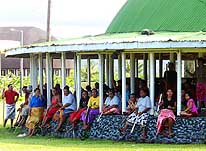
|
-
-
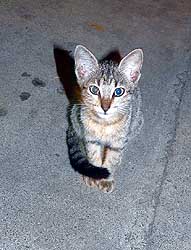
|
-
-
-
-
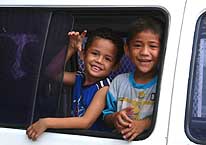
|
- 109
People gather at the traditional
- “Fale Fono” (the old Parliament
- House) – today one of the breezy
- meeting places found all over the island
|
- 110
No – unfortunately we
- cannot give you a proper home!
|
- 111
Two boys smile at us with happy faces
|
-
|
- Exactly one month later, on August 1, 2009, – returning from Pago
Pago / American Samoa on a stopover in Apia on our way to
Papeete / Tahiti in French Polynesia via Auckland in New Zealand and Rarotonga on the Cook
Islands – we enjoy some of the visited sights once more from the air:
|
-
-
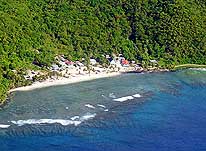
|
-
-
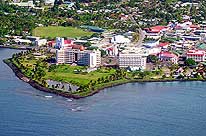
|
-
-
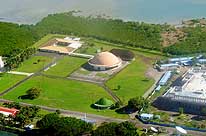
|
- 190
The village of Samamea in
- the Fagaloa Bay in the Northeast
|
- 191
Downtown Apia with the
- Government Building and the
- Central Bank in the front
|
- 192
Both Parliament Houses in the Mulinuu
- Peninsula in Apia (rose-colored roof in the
- center = new; green roof in the front = old)
|
|
-
-
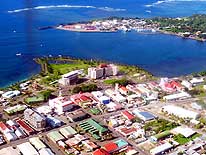
|
-
-
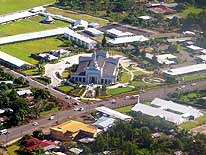
|
-
-
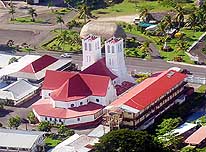
|
- 193
Downtown Apia from the South,
- with the Government Building and the
- Central Bank in the front. In the port (back-
- ground) "MV Lady Naomi" has docked
|
- 194
Main "Latter-day Saints" Temple
- at Vaitele Street in Pesega/Apia
|
- 195
The Catholic Cathedral in Apia
- viewed from its back side. The "Fale"
- behind the towers houses the Tourist Office
|
-
|
-
- More websites from Samoa:
-
-
|
- Articles in newspapers about us in Samoa:
- Article: "Switzerland couple have
travelled to 163 countries", Daily Newspaper "Samoa
Observer" - April 5, 2009
- Article: "World
travellers take fond memories", Daily Newspaper "Samoa
Observer" - July 1, 2009
- Article: "Swiss
day celebrated in Samoa", Daily Newspaper "Samoa
Observer" - August 4, 2009
|
|
![]()